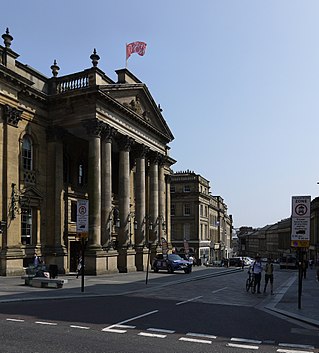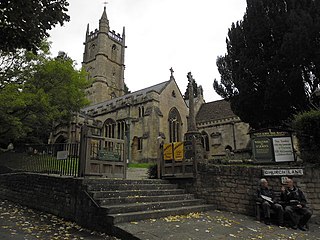
Newcastle upon Tyne, or simply Newcastle, is a city and metropolitan borough in Tyne and Wear, England. It is England's northernmost metropolitan borough, located on the River Tyne's northern bank opposite Gateshead to the south. It is the most populous settlement in the Tyneside conurbation and North East England.

Bessie Surtees House is the name of two merchants' houses on Newcastle's Sandhill, near to the river, that were built in the 16th and 17th centuries. Though commonly referred to solely as Bessie Surtees House, the property actually consists of three distinct properties; Bessie Surtees House, Milbank House, and Maddison House. These names were given to the buildings by their 20th-century owner Lord Gort. The buildings are a fine and rare example of Jacobean domestic architecture. An exhibition detailing the history of the buildings can be found on the first floor. The site is also home to the North East regional branch of Historic England. It is a Grade I listed building.

John Dobson was a 19th-century English neoclassical architect. During his life, he was the most noted architect in Northern England. He designed more than 50 churches and 100 private houses, but he is best known for designing Newcastle railway station and his work with Richard Grainger developing the neoclassical centre of Newcastle. Other notable structures include Nunnykirk Hall, Meldon Park, Mitford Hall, Lilburn Tower, St John the Baptist Church in Otterburn, Northumberland, and Beaufront Castle.

Throckley is a village in the Newcastle upon Tyne district, in the county of Tyne and Wear, England, approximately 7 miles (11 km) west of Newcastle city centre. Hadrian's Wall passed through the village, its course traced by the village's main road, Hexham Road. Throckley lies within the historic county of Northumberland.

Frosterley is a village in the civil parish of Stanhope, in County Durham, England. It is situated in Weardale, on the River Wear close to its confluence with Bollihope Burn; between Wolsingham and Stanhope; 18 miles (29 km) west of Durham City and 26 miles (42 km) southwest of Newcastle upon Tyne. In the 2001 census Frosterley had a population of 705.

Oxhill is a village in South Warwickshire, England, off the A422 road between Stratford-upon-Avon and Banbury. The population taken at the 2021census was 387. It lies in the administrative district of Stratford-on-Avon in the area known as the Vale of the Red Horse. The village is mentioned in the Domesday Book as "Octeselve" and has a 12th-century church dedicated to Saint Lawrence. The indentions in the chancel window mullions are believed by many to be the marks made by local archers sharpening their arrowheads. Because of the holiness and sacredness of the church, the blessed arrows were also presumed to have divine accuracy.

The history of Newcastle upon Tyne dates back almost 2,000 years, during which it has been controlled by the Romans, the Angles and the Norsemen amongst others. Newcastle upon Tyne was originally known by its Roman name Pons Aelius. The name "Newcastle" has been used since the Norman conquest of England. Due to its prime location on the River Tyne, the town developed greatly during the Middle Ages and it was to play a major role in the Industrial Revolution, being granted city status in 1882. Today, the city is a major retail, commercial and cultural centre.

Benwell is an area in the West End of Newcastle upon Tyne, in the county of Tyne and Wear, England. Until 1974 it was in Northumberland.

Richard Grainger was a builder in Newcastle upon Tyne. He worked with the architects John Dobson and Thomas Oliver, and with the town clerk, John Clayton, to redevelop the centre of Newcastle in the 19th century. Grainger Street and the Grainger Market are named after him; sometimes the whole area of Newcastle developed in the Neoclassical style around Grey Street and Grainger Street is referred to as Grainger Town.

Healey is a rural estate and civil parish in Northumberland, England, situated between Riding Mill to the north and Slaley to the south. The neo-Norman St John's Parish Church, which was built in 1860, was awarded the 2011 Art in a Religious Context award for its windows by Anne Vibeke Mou and James Hugonin. At the 2001 census, the parish had a population of 194, falling slightly to 191 at the 2011 Census.

Grainger Town is the historic commercial centre of Newcastle upon Tyne, England. It covers approximately 36 ha. Almost all of Grainger Town is in Newcastle's Central Conservation Area, one of the first designated in England. The area includes a mediaeval 13th-century Dominican priory, pieces of the historic Town Walls, and many fine Georgian and Victorian buildings.
Thomas Oliver was an English classical architect and surveyor active in Newcastle upon Tyne. He was one of a number of talented local architects who worked with Richard Grainger on the development of Newcastle, but his work tends to be overshadowed by that of John Dobson who has been given a great deal of the credit for the central part of the city referred to as Grainger Town.
John and Benjamin Green were a father and son who worked in partnership as architects in North East England during the early nineteenth century. John, the father was a civil engineer as well as an architect. Although they did carry out some commissions separately, they were given joint credit for many of their projects, and it is difficult to attribute much of their work to a single individual. In general, John Green worked on civil engineering projects, such as road and rail bridges, whereas Benjamin worked on projects that were more purely architectural. Their work was predominantly church and railway architecture, with a sprinkling of public buildings that includes their masterpiece, Newcastle's Theatre Royal.

St Mary Magdalen Bermondsey is an Anglican church dedicated to St Mary Magdalen in Bermondsey in the London Borough of Southwark. The majority of the present building is late 17th century and is Grade II* listed.

Knarsdale, historically Knaresdale, is a village and former civil parish, now in the parish of Knaresdale with Kirkhaugh, in Northumberland, England about 5 miles (8 km) north of Alston. The village takes its name from the Knarr Burn: Knarr means 'rugged rock'. In 1951 the parish had a population of 289.

All Saints' Church is a late 18th-century church in Lower Pilgrim Street, Newcastle upon Tyne, England, which replaced a medieval church on the same site. All Saints' Church is the only elliptical church building in England, the third tallest religious building in Newcastle and the ninth-tallest structure in the city overall. It is a Grade I listed building.
John Hodgson (1779–1845) was an English clergyman and antiquary, known as the county historian of Northumberland.

All Saints' Church, Winthorpe is a Grade II listed parish church in the Church of England in Winthorpe, Nottinghamshire, England. The current building, the construction of which was completed in 1888, is at least the third version of the church, which dates back to at least the early 13th century. All Saints' Church was commissioned by the church rector, Edward Handley, in memory of one of his relatives.

The Church of St John the Baptist in Northend, Batheaston within the English county of Somerset was built in the 12th century and remodelled in the 15th century. It is a Grade II* listed building.

St John the Baptist's Church is an Anglican church in Burslem, Stoke-on-Trent, Staffordshire, England. It is a Grade II listed building.



















